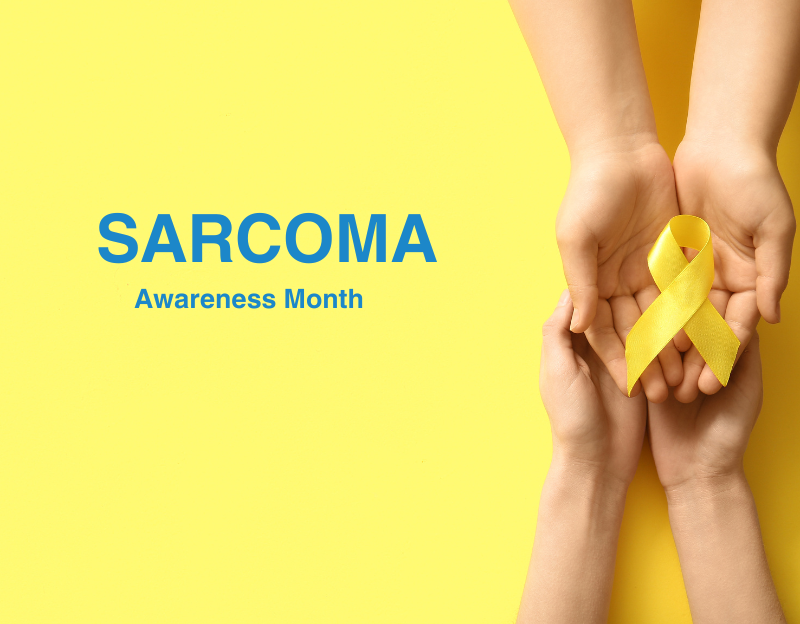
13 Sep, 2024

13 Sep, 2024
Sarcoma Awareness Month is commemorated every July to increase public awareness of sarcoma. It is also referred to as Sarcoma and Bone Cancer Awareness Month. The disease originates in connective tissues like bones and muscles.
The observance of Sarcoma Awareness Month aims at sensitizing society to the early symptoms of sarcoma, its risk factors, diagnosis, and treatment, and contributes to informed decision-making among those affected by sarcoma.
The observance of Sarcoma Awareness Month is crucial, as it educates the public and health professionals about early detection, new advances in disease management, and managing the emotional distress associated with the disease and its treatment. It also works toward advocacy and community engagement to ensure better treatment outcomes and quality of life for sarcoma patients worldwide.
July has been marked as Sarcoma Awareness Month since 2008. In November 2007, a group gathered in Seattle to unite the sarcoma non-profits. They then decided that there should be a month dedicated to raising awareness of crucial aspects associated with sarcoma.
Sarcoma is a relatively rare cancer type in India and contributes to only about 0.6% of all cancers. The theme for Sarcoma Awareness Month 2024 is “Raising Awareness to Create Survivors.” The whole idea behind this theme is to increase the chances of survival among sarcoma patients by creating awareness of the importance of early detection of sarcoma and its timely treatment.
Sarcoma is often referred to as the “forgotten cancer,” as it accounts for a very small percentage of all cancers and is also one of the most under-researched cancer types.
Reports suggest that there are more than 70 subtypes of sarcoma.
The most common sarcomas in adults are liposarcoma, undifferentiated pleomorphic sarcoma, and leiomyosarcoma.
Some types of sarcoma occur more often in certain body parts than others. For example, liposarcomas and undifferentiated pleomorphic sarcomas are most common in the legs, while leiomyosarcoma is most commonly seen in the abdomen (belly).
Sarcoma is a cancer originating from the body's connective tissues, which consist of bones, muscles, fat, cartilage, and blood vessels.
Sarcomas may occur anywhere in the body and affect both children and adults. The symptoms may depend on the location of the tumor, but they frequently involve visible lumps or swelling.
Treatment usually comprises surgery, radiation therapy, and chemotherapy. Early detection is critical to outcomes, with excellent treatment possibilities and better survival rates.
Following are the different types of sarcoma:
Soft tissue sarcoma is a rare cancer that develops in the tissues that connect the body's structures, such as muscles, fat, nerves, and blood vessels. It often appears as a painless lump. Treatment usually involves surgery with radiation and sometimes chemotherapy. Early diagnosis may lead to favorable outcomes.
Bone sarcoma is a cancer that develops in the bones, mainly in children and young adults. The types include osteosarcoma and Ewing sarcoma. Usually, it shows symptoms such as bone pain and swelling. Treatment includes surgery and chemotherapy; radiotherapy may also be advised.
Rare types of sarcomas, including angiosarcomas, originate from blood vessels, and synovial sarcomas occur near joints. Other types of sarcomas are leiomyosarcoma, which originates from the smooth muscles, and liposarcoma, found in fat cells.
The common symptoms of sarcoma are:
Some of the common causes of sarcoma are:
Some of the common treatments for sarcoma are:
Measures to prevent sarcoma include minimizing exposure to common risk factors associated with the disease, whether exposure to chemicals and radiation or genetic predisposition. Regular checkups with the doctor will allow individuals to detect the lump and make further assessments.
Healthy lifestyle choices like a balanced diet and exercise may also reduce cancer risks. Other measures include occupational safety measures and reduced exposure to environmental toxins to reduce the chances of developing sarcoma.
HCG is one of the leading comprehensive cancer hospitals in India. It is one of the most preferred oncology hospitals for sarcoma treatment because of its specialized expertise in managing disease with conventional and advanced treatment options, including surgery, radiation therapy, chemotherapy, and targeted therapy.
The healthcare providers at the center prioritize patient-centric care, ensuring personalized treatment plans based on individual needs. A multidisciplinary team of experienced oncologists and support staff diagnoses and manages sarcoma.
Sarcoma Awareness Month, observed every July, raises public awareness about this rare cancer originating in connective tissues like bones and muscles. It promotes education on early detection and advances in treatment.
Sarcoma has various types originating in connective tissues like bones and muscles. Early detection is crucial, often presenting with visible lumps or swelling.
Treatment involves surgery, radiation, and chemotherapy, with favorable outcomes linked to timely intervention. Awareness and preventive measures play critical roles in managing sarcoma.